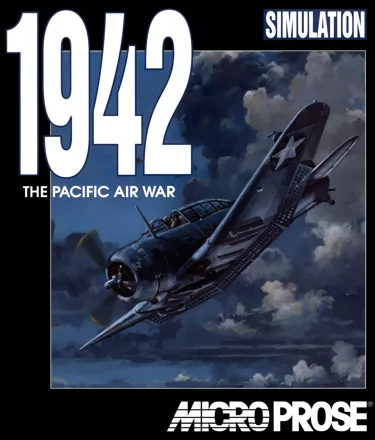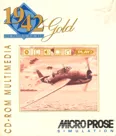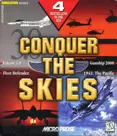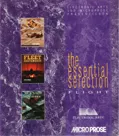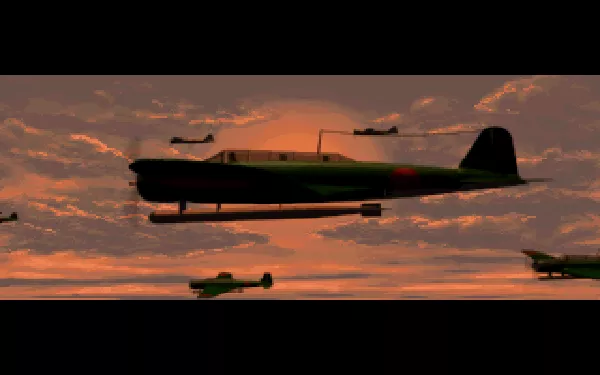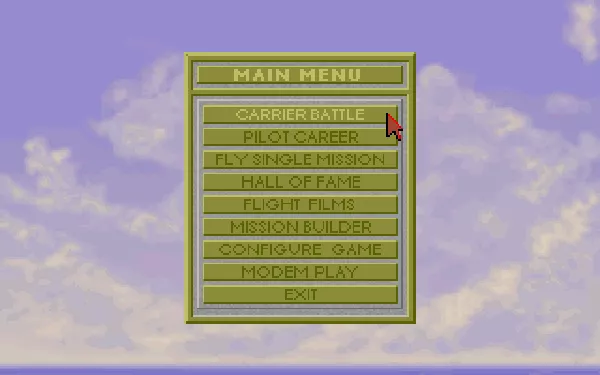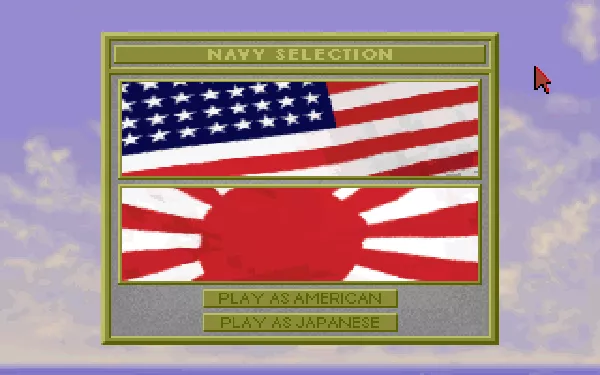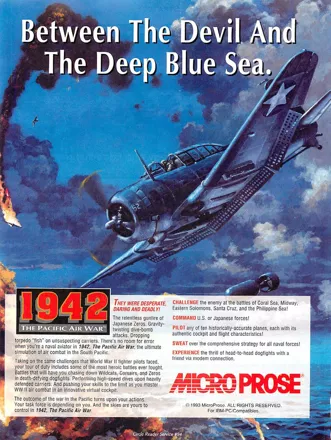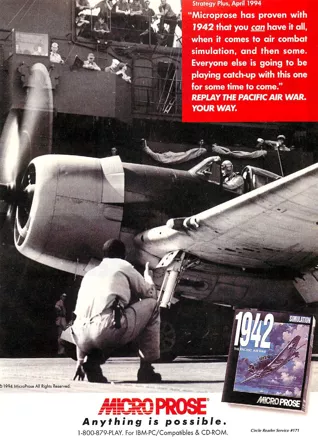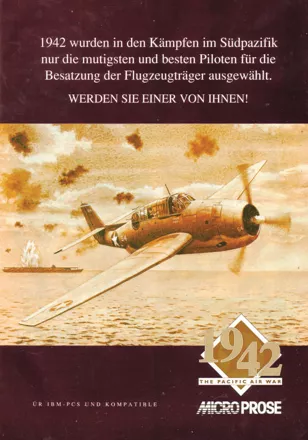1942: The Pacific Air War
Description official descriptions
1942: The Pacific Air War is a flight simulation set in World War II, more specifically the Pacific War between Japan and the United States.
The focus is on the realistic simulation of the ten aircraft. This means for instance that there is no indicator for ammo. The game features several missions which can be either played independently from each other or in two campaigns for the United States or Japan. The goals are mostly to liberate an area, to defend an area or to destroy a specific target.
The special feature of this game is that it also can be played as a strategy game. On an overhead map, the player gets presented with the position of all aircraft and they can order their troops around. The player can take control over any aircraft they wish to and switch between both modes instantly. They can also record their performance and cut small movies with different camera angles out of them.
Spellings
- 1942太平洋空戰 - Chinese spelling (traditional)
Groups +
Screenshots
Promos
Credits (DOS version)
42 People (36 developers, 6 thanks) · View all
| Game Design | |
| Sound |
|
| Manuals |
|
| Simulation & AI Programming | |
| Manual Illustrations/Photos | |
| 3D Graphics Programming | |
| Packaging | |
| 3D Object Driver Programming | |
| Carrier Battles Programming | |
| Lead Artist | |
| Miscellaneous Programming | |
| Quality Assurance | |
| [ full credits ] | |
Reviews
Critics
Average score: 81% (based on 16 ratings)
Players
Average score: 3.8 out of 5 (based on 10 ratings with 2 reviews)
A sense of authenticity that's rare to this day
The Good
I loved this game when it was new in the 1990s, and it's still impressive today. The flight model that takes account not only of energy (no manoeuvring if you're too slow), but also engine torque (unless corrected, the plane constantly tends to list to one side) and overheating (if you run at full revs for more than a few seconds).
Better yet is the limited-ammo feature. There's no way to tell how much ammo you've got left, until suddenly your guns just stop firing. If you're anything like me, that will make you play - conservatively. No just blazing away on the remote chance of hitting a distant target, and often I'll use the option to fire only a few guns at once.
Playing as a Jap fighter pilot is challenging. On the one hand, you have the sheer joy of manoeuvrability that your enemies can only dream of. But on the other, there's an acute sense of vulnerability - even a short burst from a Wildcat can finish you. Particularly later in the campaign, when Corsairs and (worse) Hellcats start to appear, the sky begins to feel a very scary place. Surviving the full 30 missions in a Zero is a real challenge. I may resort to changing the difficulty settings mid-campaign (yes, you can do that).
Conversely, as an American, in the early game you'll be cursing the slow, lumbering Wildcat compared to the graceful ease of the Zeros. When you get to fly the later planes, there's a real upgrade.
What it adds up to, for me, is an almost horrifically authentic 1940s "feel". This is old technology, and it feels like it. The graphics help to
The Bad
Little. Landing is ridiculously hard, particularly on a carrier. In theory you're supposed to be able to land, refuel and rearm during a (defensive) battle, but I've never managed it.
And the bombing missions, while sharing the same 'authenticity' feel, can be pretty anti-climactic. You dodge and fight your way past the enemy fighter cover, drop one bomb (which almost certainly misses), then dodge and fight your way back again. Torpedo runs are similar, but with the added twist that you can't even know if you've hit the target until about a full minute or more after you've launched.
No matter what you do, you can't influence the outcome of the battle or the war. Even if you fight off the American attacks at the Coral Sea and Midway, the Americans will still somehow win those battles and go on to win the war. Again, probably accurate - one pilot alone probably couldn't have made a difference - but frustrating.
Finally, there's no personalisation. It'd be nice to be able to at least give yourself a name.
The Bottom Line
A beautiful period piece. Try to look past the obvious limitations of its age, and enjoy the real sense of danger, of improvisation, of making the best with what you're given.
In campaign mode, if you get shot down (or even run out of fuel) and fail to bail out, or bail out in the wrong place, that's it - game over, your pilot goes up in the hall of fame with whatever score he's achieved at that point, and you don't get to do the mission over. That gives me a greater sense of investment in the character than any amount of personalising one's name and appearance.
DOS · by Mike Kew (5) · 2009
For the more serious simulator fan, an enjoyable tour of duty in the skies over the Pacific Theatre
The Good
The Corsair, the Zero, Wildcats and Hellcats. I love simulations of the air war in the Pacific in WW2. The extreme mismatch of dogfighting styles, the carrier landings and take-offs, the diving through flak and fighter cover to bomb capital ships...1942:The Pacific Air war models all these things. Carrier landings are a risky task that requires practice (or extensive use of the auto-piloting feature). Japanese fighters will weave in and out of your formations, while American fighters will brazenly bust their way through in run'n'shoot maneuvers. The planes behave fairly accurately (granted my real flight experience is merely in a period trainer) and fuel and ammunition limitations are always on one's mind.
For their day, the graphics were pretty and, aside from being in an incredibly low resolution, are passable these days still. The planes have detailed (considering the resolution) skins, while the lesser used objects, like ground objects and ships are more simplified. More important, the graphics serve their purpose, although sometimes the blue painted fighters can be lost against the texture of the sea and the green fighters obscured by the green islands, but this is actually something pilots had to deal with the whole point of the color schemes to begin with.
The targeting padlock feature, popular since Falcon 3, is a much needed feature in WW2 simulators, where up close dogfights are common and you need to know what your opponent is doing long before he's in your sights. Though it may take sometime getting use to, the padlock in 1942:PAW serves its purpose well.
The Bad
Early versions had bugs galore with everything from stupid AI to unrealistic anti-aircraft fire. Later versions fix most of these issues.
Even with the patches, the AI is lacking in some categories. If you wish to permanently lose a pair of fighters on your tail, dive down and skim sea level (or fly through some valleys on the larger islands). Chances are that your enemies will never pull out, or insanely attempt a fatal vertical maneuver.
Stalls are a little more frequent than one should expect and cause spins nearly everytime. Although easy to get out of if you know the trick, these spins interrupt the game and happen a lot more than they should.
Until the add-on (and subsequent 'Gold' version), Microprose left out one of my favorite Pacific War Theatre aircraft: the USAF Lockheed P-38 Lightning. Not so much a dislike as a disappointment with the original version.
Not everyone will like the overly realistic issues. You need a steady hand, a good judge of alignment, and patience to score kills. Otherwise you'll just spray your very limited ammunition across the sky. Fortunately, players who don't want to deal with this realism can turn on options such as unlimited weaponry.
The Bottom Line
A pretty, fairly realistic mid-90's WW2 Flight-sim featuring the conflict between the Japanese and Americans over the Pacific Ocean. Dated graphics and sometimes over-realistic aspects might turn off some, but a fan of WW2 flight sims may want to check it out, especially if their only experience is with the European Theatre.
DOS · by Ray Soderlund (3501) · 2000
Trivia
AI
The AI in the game actually gives "stick and rudder" commands to each of the planes it controls. You can see the ailerons, elevators, and rudders move realistically.
Extras
1942: The Pacific Space War comes with a Pilot Handbook which, in turn, contains a magnificent historical overview of World War II.
Gameplay
Technically, it is NOT necessary for you to fly the planes personally. The game has a full strategic engine that can simulate all conflicts. You could just click on the carrier(s) and issue orders like arm for strike and things like that.
Information also contributed by Kasey Chang
Analytics
Upgrade to MobyPro to view research rankings!
Identifiers +
Contribute
Are you familiar with this game? Help document and preserve this entry in video game history! If your contribution is approved, you will earn points and be credited as a contributor.
Contributors to this Entry
Game added by MAT.
Additional contributors: Tomer Gabel, PCGamer77, Paulus18950, Patrick Bregger.
Game added March 27, 2000. Last modified February 8, 2024.
